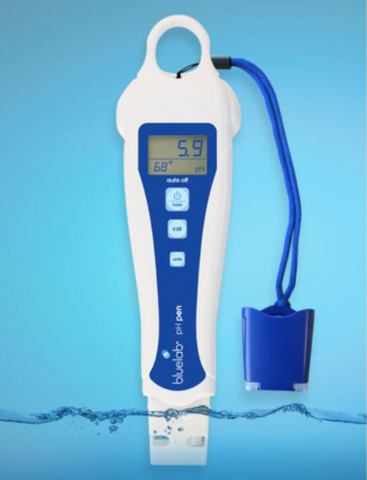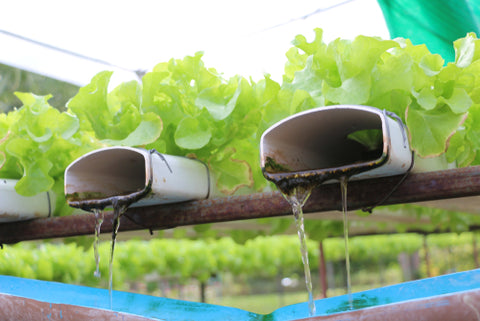
Everything You Need To Know About Water Testing
In a hydroponic growing system, water is the primary medium for delivering nutrients to your plants. Poor water quality can cause disease, toxicity, dehydration, low yield, and other growing concerns. Bad water can kill your plants in days, if not hours. Certain water imbalances can also cause a backup in your hydroponic pumps and drips, damaging your system and potentially costing a significant amount for repair or replacement.
In a hydroponic system, you have direct control over the nutrients that you provide to your plants. But if the water is unbalanced and doesn’t correlate to the plants’ needs, the water can’t deliver those nutrients properly.
Water testing looks at the quality of water to ensure that your plants always have access to clean water and a proper intake of nutrients.
What should you be testing and what can you do to simplify this process?
What To Test
There are three key variables you want to test for in your water: pH, conductivity (EC), and temperature.
1. pH
pH is a measure of acidity in the water. A pH of less than 7 is acidic and a pH greater than 7 is basic or alkaline. The ideal pH for humans is 7.3 to 7.45, but each plant has its own unique pH.
The pH level of your water will tell you the nutrient uptake of the plants. Most plants have a specific pH range that will allow them to intake optimal nutrient levels. If the pH is too high, too low, or changes too drastically, it can shock and kill plants in just a few hours.
There are three key factors that influence water pH in a hydroponic system: alkalinity, carbon dioxide, and hardness.
Alkalinity looks at the concentration of bicarbonate (HCO3) in the water. Bicarbonate elevates pH and can influence the plant’s capacity to accept nutrients.
Carbon dioxide (CO2) can create a high pH as well. In some cases, especially with groundwater, some CO2 can escape the water and into the atmosphere. This causes the water to lose acidity, raising the pH.
“Hardness” looks at the combined concentration of calcium and magnesium. Calcium and magnesium are necessary plant nutrients that can help your crops grow. However, too much can cause “hard” water that raises pH levels. Hard water is especially damaging to recirculating hydroponic systems, as it can create a white precipitate that blocks pipes and drippers. You can usually avoid hard water with “base exchange” resins or by maintaining a pH below 6.

Measure pH
To measure the pH, you can use a simple Bluelab pH pen, which will quickly tell you the pH level and any necessary adjustments to the water.
We recommend the Bluelab pH Controller, which constantly monitors and adjusts the pH levels for you. It uses clever monitoring, dosing, and data logging technology to check pH, dose up or down, and wirelessly log data into the computer. This is a great option if you want to keep your plants and water healthy without time-consuming daily pH checkups.
Change pH
pH is easy to regulate with a hydroponic solution from Bluelab. You follow the instructions on the bottle of pH Up or pH Down to see how much to add to your system based on the current versus desired pH and the size of the reservoir.
In most cases, you’ll need to lower the pH. pH can rise due for a number of reasons, and a pH Down solution can help regulate the pH to an appropriate level.
It’s rare that you’ll have to raise pH unless you’re using an RO filter. If you do need to raise the pH, though, you’ll want to use a pH Up solution.
2. Conductivity
Conductivity (EC) measures the amount of salts or nutrients in your system. This tells you how much food is available to your plants through the water.
These “salts” include sodium chloride (common salt), calcium, magnesium bicarbonates, chlorides, and sulfates. The most common are sodium and chloride, which can be toxic to plants in high enough levels. Sulfates, calcium, and magnesium are necessary nutrients, but they can create “hard” water that affects pH, as discussed above.
In a recirculating hydroponic system, excess salts can accumulate and block the pipes. This is especially true in hot grow tents, where water will evaporate from the reservoir and leave behind extra salts. This creates a higher EC, which can damage plants by over-feeding or over-diluting.
Measure EC
The ideal EC should be between 1.2 and 2 to deliver optimal nutrients.
You’ll want to check the ppm of the water as well. Tap water with a ppm of 300 or greater needs to be distilled or go through reverse osmosis. You want your water base to be between 0-50 ppm before adding nutrients. Any higher than 100ppm and the water may have damaging micro bacteria.
To measure EC, we recommend a Bluelab ppm Pen. This measures both conductivity and temperature to ensure you don’t over- or under- concentrate the nutrient solution.
Change EC
If the EC is too strong, add fresh distilled water. If the EC is too weak, add extra nutrients.

3. Temperature
The ideal water temperature for most plants is between 65 and 72 degrees Fahrenheit. Freezing or boiling water can damage your plant’s roots and not conduct nutrients appropriately.
Some plants require specific temperature ranges in order to flower, bud, and grow.
Measure Temperature
Most meters and controllers will measure temperature along with pH and conductivity. Temperature is usually the easiest to measure and regulate.
Change Temperature
If the temperature is drastically too high or low, we recommend replacing the water entirely. If it’s off by a few degrees, look at the variables in your grow tent. If it’s too hot, your sunlamps and grow tent reflectors may be too intense. If the water is too cool, you may not have enough warm air circulating in the room.
Consult with a professional to learn more about your plants’ specific pH, EC, and temperature needs.
You may also want to test for:
- Iron
- Corrosiveness
- Contamination/pollution
- Cloudiness
- Color
- Odor
- Slimes/algae
How To Measure
You need meters and controllers to measure the pH, conductivity, and temperature.
You should keep notes in a diary or log to record the changes and track any patterns. For example, you may notice that the temperature and EC increase when the sunlamps are on and decreases when the sunlamps are off. This likely means your sunlamps are letting off too much heat.
You should also test the water with and without nutrients. In order to get an accurate reading, you should test the water both after you add the nutrient solution and after the nutrients have run through the system twice. This helps you see how the nutrients are impacting the system in the short- and long-term.
Check out the Bluelab Grower’s Toolbox, which gives you everything you need to monitor your system. It consistently and effectively measures pH, ppm, and temperature. It’s great for beginners learning how to test their water or for advanced growers who want something simple and easy to use!

When To Test
You should test water before giving the water to your plants and throughout the nutrient distribution.
You want to test the water beforehand to make sure that the water is properly clean and clear, not introducing harmful bacteria or unbalanced levels to your plants. To ensure clean water, we recommend collecting and distilling rainwater or using a reverse osmosis process to remove any bacteria or contaminants from your regular supply of water. Some growers will also purchase distilled water, but this can get costly over time.
You also want to test continuously throughout the growth of your plants. We recommend daily testings, especially for a new system or new crop. Testing for balance is also especially important during the flowering and budding stages.
You should test at different times of day, multiple days throughout the week. This gives you a more comprehensive reading of your water to understand exactly how your plants are receiving the nutrient solution.
Remember: nutrient delivery is the key to plant growth and yield.
You should also re-test after you make any changes to the water. For example, if you add pH Down, it could impact the conductivity of the water. You’ll want to re-test the water to ensure that everything stays level.
The Bottom Line
Testing, monitoring, and adjusting your water consistently will ensure your plants always have an appropriate intake of nutrients.
Make it easy for yourself and install the Bluelab Guardian Monitor.
This system monitors pH, conductivity, and temperature on a continuous, 24-hour basis. It will alert you when the variables are “high” or “low,” so you can quickly and easily adjust accordingly. The LED displays will show changes in real-time, so you can monitor how much of the pH or conductivity solution you should add.
Install a Bluelab Guardian Monitor to consistently monitor your water to ensure your plants are always receiving the optimal level of nutrients and water.
Not sure how to create the peak balance water for your plants? Contact HydroPros now for a free consultation!

Leave a comment